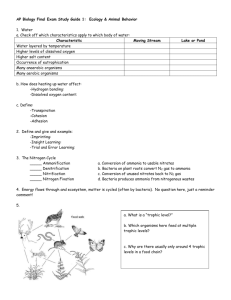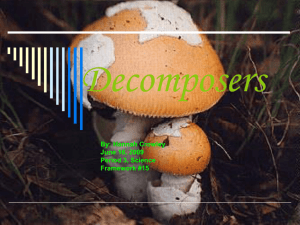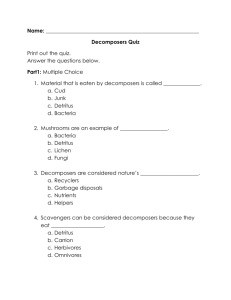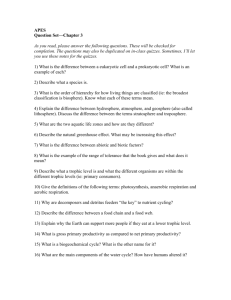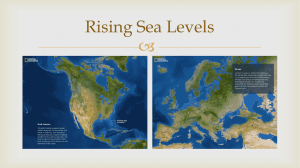Energy and Matter
advertisement
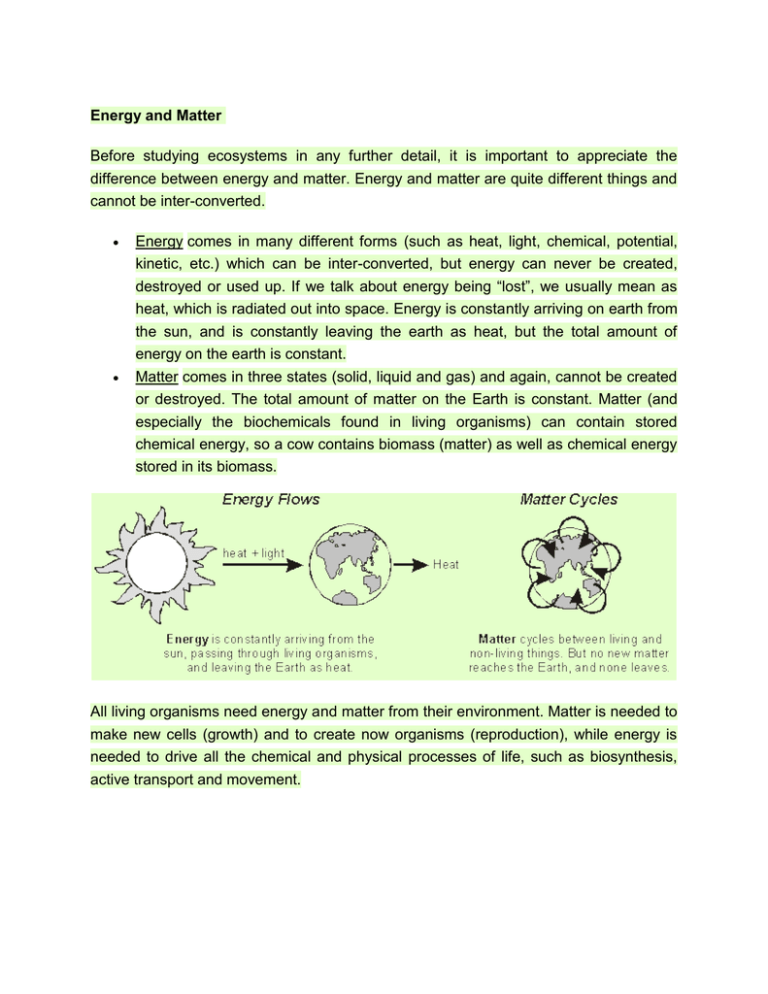
Energy and Matter Before studying ecosystems in any further detail, it is important to appreciate the difference between energy and matter. Energy and matter are quite different things and cannot be inter-converted. Energy comes in many different forms (such as heat, light, chemical, potential, kinetic, etc.) which can be inter-converted, but energy can never be created, destroyed or used up. If we talk about energy being “lost”, we usually mean as heat, which is radiated out into space. Energy is constantly arriving on earth from the sun, and is constantly leaving the earth as heat, but the total amount of energy on the earth is constant. Matter comes in three states (solid, liquid and gas) and again, cannot be created or destroyed. The total amount of matter on the Earth is constant. Matter (and especially the biochemicals found in living organisms) can contain stored chemical energy, so a cow contains biomass (matter) as well as chemical energy stored in its biomass. All living organisms need energy and matter from their environment. Matter is needed to make new cells (growth) and to create now organisms (reproduction), while energy is needed to drive all the chemical and physical processes of life, such as biosynthesis, active transport and movement. Food Chains and Webs The many relationships between the members of a community in an ecosystem can be described by food chains and webs. Each stage in a food chain is called a trophic level, and the arrows represent the flow of energy and matter through the food chain. Food chains always start with photosynthetic producers (plants, algae, plankton and photosynthetic bacteria) because, uniquely, producers are able to extract both energy and matter from the abiotic environment (energy from the sun, and 98% of their matter from carbon dioxide in the air, with the remaining 2% from water and minerals in soil). All other living organisms get both their energy and matter by eating other organisms. Although this represents a “typical” food chain, with producers being eaten by animal consumers, different organisms use a large range of feeding strategies (other than consuming), leading to a range of different types of food chain. Some of these strategies are defined below, together with other terms associated with food chains. Producer An organism that produces food from carbon dioxide and water using photosynthesis. Can be plant, algae, plankton or bacteria. Consumer An animal that eats other organisms Herbivore A consumer that eats plants (= primary consumer). Carnivore A consumer that eats other animals (= secondary consumer). Top carnivore A consumer at the top of a food chain with no predators. Omnivore A consumer that eats plants or animals. Vegetarian A human that chooses not to eat animals (humans are omnivores) Autotroph An organism that manufactures its own food (= producer) Heterotroph An organism that obtains its energy and mass from other organisms (=consumers + decomposers) Plankton Microscopic marine organisms. Phytoplankton “Plant plankton” i.e. microscopic marine producers. Zooplankton “Animal plankton” i.e. microscopic marine consumers. Predator An animal that hunts and kills animals for food. Prey An animal that is hunted and killed for food. Scavenger An animal that eats dead animals, but doesn't kill them Detritus Dead and waste matter that is not eaten by consumers Carrion Alternative word for detritus Decomposer An organism that consumes detritus (= detrivores + saprophytes) Detrivore An animal that eats detritus. Saprophyte A microbe (bacterium or fungus) that lives on detritus. Symbiosis Organisms living together in a close relationship (= parasitism, mutualism, pathogen). Mutualism Two organisms living together for mutual benefit. Commensalism Relationship in which only one organism benefits Parasite An organism that feeds on a larger living host organism, harming it Pathogen A microbe that causes a disease. So food chains need not end with a consumer, and need not even start with a producer, e.g.: Ecological Pyramids In general as you go up a food chain the size of the individuals increases and the number of individuals decreases. These sorts of observations can be displayed in ecological pyramids, which are used toquantify food chains. There are three kinds: 1. Pyramids of Numbers. These show the numbers of organisms at each trophic level in a food chain. The width of the bars represent the numbers using a linear or logarithmic scale, or the bars may be purely qualitative. The numbers should be normalised for a given area for a terrestrial habitat (usually m²), or volume for a marine habitat (m³). Pyramids of numbers are most often triangular (or pyramid) shaped, but can be almost any shape. In the pyramids below, A shows a typical pyramid of numbers for carnivores; B shows the effect of a single large producer such as a tree; and C shows a typical parasite food chain. 2. Pyramids of Biomass These convey more information, since they consider the total mass of living organisms (i.e. the biomass) at each trophic level. The biomass should be dry mass (since water stores no energy) and is measured in kg m -2. The biomass may be found by drying and weighing the organisms at each trophic level, or by counting them and multiplying by an average individual mass. Pyramids of biomass are always pyramid shaped, since if a trophic level gains all its mass from the level below, then it cannot have more mass than that level (you cannot weigh more than you eat). The "missing" mass, which is not eaten by consumers, becomes detritus and is decomposed. 3. Pyramids of Energy Food chains represent flows of matter and energy, so two different pyramids are needed to quantify each flow. Pyramids of energy show how much energy flows into each trophic level in a given time, so the units are usually something like kJ m -2 y-1. Pyramids of energy are always pyramidal (energy cannot be created), and always very shallow, since the transfer of energy from one trophic level to the next is very inefficient The “missing” energy, which is not passed on to the next level, is lost eventually as heat. Energy Flow in Ecosystems Three things can happen to the energy taken in by the organisms in a trophic level: It can be passed on to the biomass of the next trophic level in the food chain when the organism is eaten. It can become stored in detritus. This energy is passed on to decomposers when the detritus decays. It can be converted to heat energy by inefficient chemical reactions, radiated by warm bodies, or in friction due to movement. The heat energy is lost to the surroundings, and cannot be regained by living organisms. These three fates are shown in this energy flow diagram: Eventually all the energy that enters the ecosystem will be converted to heat, which is lost to space. Material Cycles in Ecosystems Matter cycles between the biotic environment and in the abiotic environment. Simple inorganic molecules (such as CO2, N2 and H2O) are assimilated (or fixed) from the abiotic environment by producers and microbes, and built into complex organic molecules (such as carbohydrates, proteins and lipids). These organic molecules are passed through food chains and eventually returned to the abiotic environment again as simple inorganic molecules by decomposers. Without either producers or decomposers there would be no nutrient cycling and no life. The simple inorganic molecules are often referred to as nutrients. Nutrients can be grouped as: major nutrients (molecules containing the elements C, H and O, comprising >99% of biomass);macronutrients (molecules containing elements such as N, S, P, K, Ca and Mg, comprising 0.5% of biomass); and micronutrients or trace elements (0.1% of biomass). Macronutrients and micronutrients are collectively called minerals. While the major nutrients are obviously needed in the largest amounts, the growth of producers is usually limited by the availability of minerals such as nitrate and phosphate. There are two groups of decomposers: Detrivores are animals that eat detritus (such as earthworms and woodlice). They digest much of the material, but like all animals are unable to digest the cellulose and lignin in plant cell walls. They break such plant tissue into much smaller pieces with a larger surface area making it more accessible to the saprophytes. They also assist saprophytes by excreting useful minerals such as urea, and by aerating the soil. Saprophytes (or decomposers) are microbes (fungi and bacteria) that live on detritus. They digest it by extracellular digestion, and then absorb the soluble nutrients. Given time, they can completely break down any organic matter (including cellulose and lignin) to inorganic matter such as carbon dioxide, water and mineral ions. Detailed material cycles can be constructed for elements such as carbon, nitrogen, oxygen or sulphur, or for compounds such as water, but they all have the same basic pattern as the diagram above. We shall only study the carbon and nitrogen cycles in detail. The Carbon Cycle As this diagram shows, there are really many carbon cycles here with time scales ranging from minutes to millions of years. Microbes play the major role at all stages. Far more carbon is fixed by microscopic marine producers (algae and phytoplankton) from CO2 dissolved in the oceans than by terrestrial plants from CO2 in the air. During the Earth's early history (3000 MY ago) photosynthetic bacteria called cyanobacteria changed the composition of the Earth's atmosphere by fixing most of the CO2 and replacing it with oxygen. This allowed the first heterotrophic cells to use oxygen in respiration. A large amount of the fixed carbon is used by marine zooplankton to make calcium carbonate shells. These are not eaten by consumers and cannot easily be decomposed, so turn into carboniferous rocks (chalk, limestone, coral, etc). 99% of the Earth's carbon is in this form. The decomposers are almost all microbes such as fungi and bacteria. Most of the detritus is in the form of cellulose and other plant fibres, which eukaryotes cannot digest. Only a few bacteria posses the cellulase enzymes required to break down plant fibres. Herbivorous animals such as cows and termites depend on these bacteria in their guts. Much of the CO2 that was fixed by ferns during the carboniferous era (300 MY ago) was sedimented and turned into fossil fuels. The recent mining and burning of fossil fuels has significantly altered the carbon cycle by releasing the carbon again, causing a 15% increase in CO2 in just 200 years. The Nitrogen Cycle Microbes are involved at most stages of the nitrogen cycle: Nitrogen Fixation. 78% of the atmosphere is nitrogen gas (N2), but this is inert and can’t be used by plants or animals. Nitrogen fixing bacteria reduce nitrogen gas to ammonia (N2 + 6H 2NH3), which dissolves to form ammonium ions (NH4+ ). This process uses the enzyme nitrogenase and ATP as a source of energy. The nitrogenfixing bacteria may be free-living in soil or water, or they may live in colonies inside the cells of root nodules of leguminous plants such as clover or peas. This is an example of mutualism as the plants gain a source of useful nitrogen from the bacteria, while the bacteria gain carbohydrates and protection from the plants. Nitrogen gas can also be fixed to ammonia by humans using the Haber process, and a small amount of nitrogen is fixed to nitrate by lightning. Nitrification. Nitrifying bacteria can oxidise ammonia to nitrate in two stages: first forming nitrite ions NH4+NO-2 then forming nitrate ions NO-2NO-3. These are chemosynthetic bacteria, which means they use the energy released by nitrification to live, instead of using respiration. Plants can only take up nitrogen in the form of nitrate. Denitrification. The anaerobic denitrifying bacteria convert nitrate to N2 and NOx, which is then lost to the air. This represents a constant loss of “useful” nitrogen from soil, and explains why nitrogen fixation by the nitrifying bacteria and fertilisers are so important. Ammonification. Microbial saprophytes break down proteins in detritus to form ammonia in two stages: first they digest proteins to amino acids using extracellular protease enzymes, then they remove the amino groups from amino acids using deaminase enzymes.

